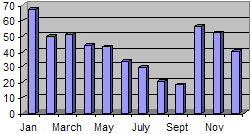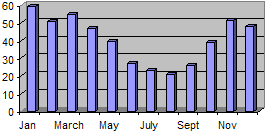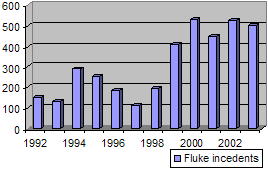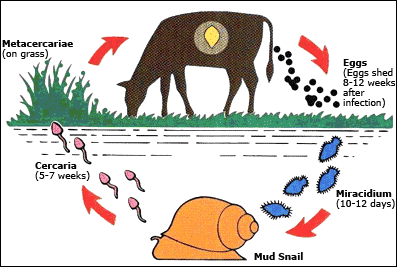



Fluke Facts
By Merial. Liver fluke infection of cattle – the facts, statistics and effects on production and control of the disease: for further information on any of these items, just click on one of the entries from the list below.How does liver fluke infection affect production in cattle?
Adult fluke live in the bile ducts and liver of cattle - usually these adults have the greatest influence on productivity. Most liver damage occurs when adult fluke enter the bile ducts.
Each fluke can cause the loss of 0.5ml of blood per day from the liver. A moderate infestation in cattle of 100-200 fluke can lead to blood loss of up to half a litre each week, so often infected animals can be anaemic.
In cattle, fluke can cause a loss in body condition, a drop in milk yield and fertility, and sometimes diarrhoea. It can also increase susceptibility of the animals to other infections and metabolic disorders.
Liver damage by flukes is often the trigger factor for Black disease – a fatal disease caused by Clostridium oedematiens.
Fluke infestation depresses appetite and consequently decreases weight gain. In one study healthy cattle consumed over 10 per cent more feed per day than animals infected with fluke.
Fluke has a negative impact on the reproductive efficacy of dairy heifers. A study showed that age to first oestrus was delayed by 39 days in infected animals.(1)
Fluke can cause sufficient damage to the liver to impair the body’s ability to convert feed into body mass.
Milk production in infected animals can drop by as much as 8%.(13)
A high incidence of liver fluke infestation can reduce milk butterfat concentration.(7)
Conception rates in fluke infected animals are reduced.(13).
Reproductive performance in fluke infected bull’s falls.(13)
Livers affected with liver flukes are condemned at the abattoirs.
Statistics on liver fluke infection in cattle
Figures released by the VLA show the number of cases of fluke infection in cattle was 42 per cent higher in 2003 than 2002.
From VLA figures it is seen that liver fluke disease in cattle is an all year round problem.
VLA diagnoses of liver fluke disease are highest during winter months.
However about half the incidents reported by the VLA occur during the grazing season.
VLA figures show that liver fluke affects all ages of cattle, including young calves.
According to DARDNI, in Northern Ireland liver condemnations due to fasciolosis in cattle were almost 40% in 2003.
- A cattle fluke treatment costs approximately £1.10 to £1.80 for a 300kg animal.
- The cost of a fluke and worm treatment for a 300kg animal is between £1.80 and £3.60.
Current estimates suggest the parasite costs the farmer between 10 and 15% per animal as a direct result of the infection. Typically, this puts the loss at around £20 per head.(2)
The number of outbreaks of fluke disease in cattle recorded by SAC Veterinary Centres during 2004 was markedly higher than the same period in 2003, as was the number of farms on which the disease was suspected.
The continuing problem of fasciolosis in cattle, despite the reduction in sheep is likely to be associated with a number of factors. These include failure to treat cattle for the disease and possibly the perception that cattle performance is unaffected by fluke challenge.
- Liver fluke infection in growing cattle has been shown to depress liveweight gain by between 0.07 kg/week and 1.2 kg/week, depending on the size of the fluke burden.(11)
- Suggested values for milk loss due to liver fluke infection are up to 1.0 kg/day over a 305 day lactation.(11)
- Liver fluke infection in a herd results in an extra 0.5 services per conception and increases the calving interval by 20 days.(11)
- The effects of liver fluke disease are estimated to cost the British cattle industry approximately £23 million.(12)
- It is estimated that liver fluke affects 377 cattle per 1,000 head.(12)
- The loss in milk production on British farms due to liver fluke is estimated to cost on average £5.8 million/year to the industry.(12)
- Climate change – with milder winters and wetter summers
- Increased movement of infected animals (introduction into previously unaffected areas)
- Environmental changes – encouragement of wet lands
- Drug resistance
The incidence of fluke
VIDA reports show the following incidents as reported by the VLA's.
1993-2003 Aveage Fluke Incidents

Fluke Incidents -VLA

Data are also available on the regional incidence of fluke and the growth of these incidents over the past few years.
Treatment of liver fluke infection in cattle
Treatment considerations
Any treatment control programme is aided by preventing cattle grazing the snail habitat or by removal of the snail habitat (through drainage) where possible. But neither of these options may be practical.
A number of products are available for treating fluke in cattle. Cattle tend to suffer chronic fluke infections, that is most of the population are adult. Most products will be effective, but seek veterinary advice if you have not treated before.(6)
Use flukicides as part of a strategic dosing regime, which means treating the stock in such a way as to limit fluke egg output at critical times of the year, such as spring and early summer. This will help break the fluke life cycle, potentially reducing problems later in the year.
Advice for farmers on flukicide usage, particularly with regard to frequency, should take account of the previous farm history, results of abattoir returns, if they are available, and faecal monitoring, tempered with the knowledge that triclabendazole-resistant flukes have been recorded in the UK and Eire.
Abattoirs do monitor liver condemnations to fluke and some provide this information to their farmers, which:
- alerts the producer of a fluke problem existing within their herd
- allows farmers to incorporate a treatment programme within their herd health plans to limit or eliminate liver damage from fluke
- enables farmers to understand where and when fluke damage may have occurred – either on their farm or from a particular source of purchased animals
- encourages treatment to improve productivity
- can improve the health and welfare status of the herd
Control of liver fluke disease should be an important part of a farm health plan drawn up with your local veterinary surgeon. Monitoring the levels of infection in sheep and cattle using fluke egg counts, abattoir returns and veterinary investigation of ill-thrifty animals is an essential part of successful control.
There are no validated on-farm tests for use in cattle to confirm the presence of resistant fluke and in vitro tests for resistance are not routinely available.(5)
Treatments and timings
Beef cattle and dairy young stock in their second seasonWhere the cattle are out-wintered, for example suckler cows, they should be treated twice with a product such as TRODAX® (nitroxynil). Once during the October/December period to remove the infection that has built up over the summer months and a second time in April or May to remove any fluke infection which may have been picked up over the winter months. This will help to limit the risk of subsequent egg contamination of the pasture.
Where cattle have been treated during the housing period they should be essentially free of infection at turnout. Subsequent treatment should be timed for the mid-summer period. This might be combined with a worm treatment for convenience, using a product such as IVOMEC Super. This too will help to reduce pasture contamination.
Where possible there may be a benefit in delaying the housing treatment until 5-8 weeks after housing to ensure all larval stages of fluke have matured to adulthood and then treating with a flukicide such as TRODAX, or combine the fluke treatment with worm dose using a product such as IVOMEC Super.
Resistance to triclabendazole has been reported in both the UK and Ireland. Where this is suspected discuss the issue with your vet and choose an alternative drug.
In their first year, spring born calves are unlikely to require treatment until housing and autumn born calves should be treated mid-summer in combination with the routine wormer treatment.
There are no flukicides available with a nil milk withdrawal period therefore for routine control treat dairy cows at drying off.
In urgent clinical cases dairy cows need to be treated and the appropriate withholding period applied.
Witholding period information is carried on the product label and datasheet and advice should be sought from a veterinary surgeon.
Avoiding the introduction of fluke, some of which may be resistant to triclabendazole, onto farms is important, advises Merial Animal Health.
According to DEFRA, all animals should be treated with a flukicide effective against immature fluke on arrival on the farm and kept on quarantine pastures, or pastures with no fluke habitat for at least four weeks after treatment.4 The use of triclabendazole should be carefully evaluated in this context as it currently appears to be the only product where significant resistance has been reported.
References
1. M. C. Lopez-Diaz et al, Theriogenology, 1998
2. A McGowan & R Laven, The Cost of Liver Fluke to the Scottish Industry, 2004
3. SAC Technical Note, TN557, November 2003
4. SCOPS, A Technical Manual for Veterinary Surgeons and Advisers, March 2004
5. Veterinary Review, September 2004, 25-26
6. NADIS Cattle Disease Focus, 2003
7. Department of Agriculture and Rural Development, Technical Note, Dairy, 13, April 2003
8. Liver fluke disease in sheep, Dr Bob Coop, Moredun Group
9. NADIS, April 2004
10. Livestock Knowledge Transfer, Beef Parasites factsheet, 2001
11. The University of Reading, Department of Agricultural and Food Economics, The Economics of Fascioliasis (Liver fluke)
12. R Bennett et al, Economic Assessment of Livestock Diseases in Great Britain, 2003
13. Merial Animal Health, Don’t let fluke stop you getting results, 2000
Background Information on liver fluke
Liver fluke disease (fasciolosis) is caused by the trematode parasite Fasciola hepatica.
Disease can result from the migration of large numbers of immature flukes through the liver, or from the presence of adult flukes in the bile ducts, or both.
Liver fluke disease affects both cattle and sheep and is an all year round problem.
Sheep are more prone to the acute form of the disease and this can be fatal.
Cattle typically suffer from chronic disease, rather than the acute form and fatalities are not so common with this type of infection.
Liver fluke are not host specific – it’s exactly the same fluke that affects all grazing animals (cattle, sheep, deer, rabbits etc). Mixed grazing is therefore not a useful control measure in high-risk fluke areas.
Youngstock tend to be more susceptible to fluke, however cattle and sheep do not develop sufficient levels of immunity and can still suffer from disease as adults, therefore fluke treatment for older animals is also necessary.
If fluke is not properly controlled then livers will become permanently damaged. After heavy infestation with liver fluke and treatment with a flukicide the liver will not fully recover.
Where possible livestock should be kept away from waterlogged areas and fresh drinking water supplied rather than natural pools where fluke snails may be prevalent.
The level of fluke infection varies from season to season and is dependent on a number of factors:
- the weather in the previous year – from August to October. Mild temperatures and above average rainfall provide optimum conditions for fluke development
- the weather in the current year – from May to July. Above average rainfall provides optimum conditions for fluke development
- incidence of liver fluke in the previous year. When incidence has been high previously it facilitates fluke development in subsequent years
- in recent years, irrespective of moderately dry times VLA reports show that fluke disease is seen throughout the year.
With changing weather patterns and management there has been a significant increase in the incidence of liver fluke in cattle and sheep and is appearing now in areas of the country where traditionally, it has not been associated.
Wet areas on farms are high risk, and can remain so even in dry summers.(10)
Life cycle of liver fluke
The life cycle of the liver fluke is very complicated. A simplified version is shown below:

- The adult liver fluke in the liver of its host produces eggs which pass onto the pasture
- These eggs hatch in warm damp conditions to produce mobile larvae (miracidia) which then infect a particular species of snail
- The larvae multiply within in the snail and develop into another swimming stage (cercaria), which emerge from the snail and settle on the pasture
- These then develop into a highly tolerant non-mobile stage (metacercaria) that can survive for at least a year. Once eaten by the cow these hatch and migrate to the liver.
Fluke eggs do not develop significantly or hatch below 10oC – therefore the lifecycle of the liver fluke is mainly completed between May and October.
Although snails often carry infection throughout the year, two main peaks of snail infection are recognised, (summer infection and winter infection) the timing of which is dependent on climatic conditions (8).
Summer infection – snails become infected with miracidia in late spring/early summer; either from fluke eggs deposited by grazing animals in spring, or from those deposited on the pasture the previous autumn/winter. This eventually can lead to clinical disease early/mid winter.
Winter infection – As the snails become inactive during winter the development and shedding of the miracidia can no longer be completed, so they remain dormant within the snail until the following spring. This winter infection acts as a reservoir of infection for the following year.
Acute fasciolosis: late autumn/early winter
Sub acute fasciolosis: late autumn to spring
Chronic fasciolosis: winter and spring
Each adult fluke can be up to 3cm long.
Adult liver fluke can survive in cattle from six months to two years.
Larval development in the snail is dependent on temperature (and rainfall); from 20 days at 30oC to 80 days at 15ºC.


